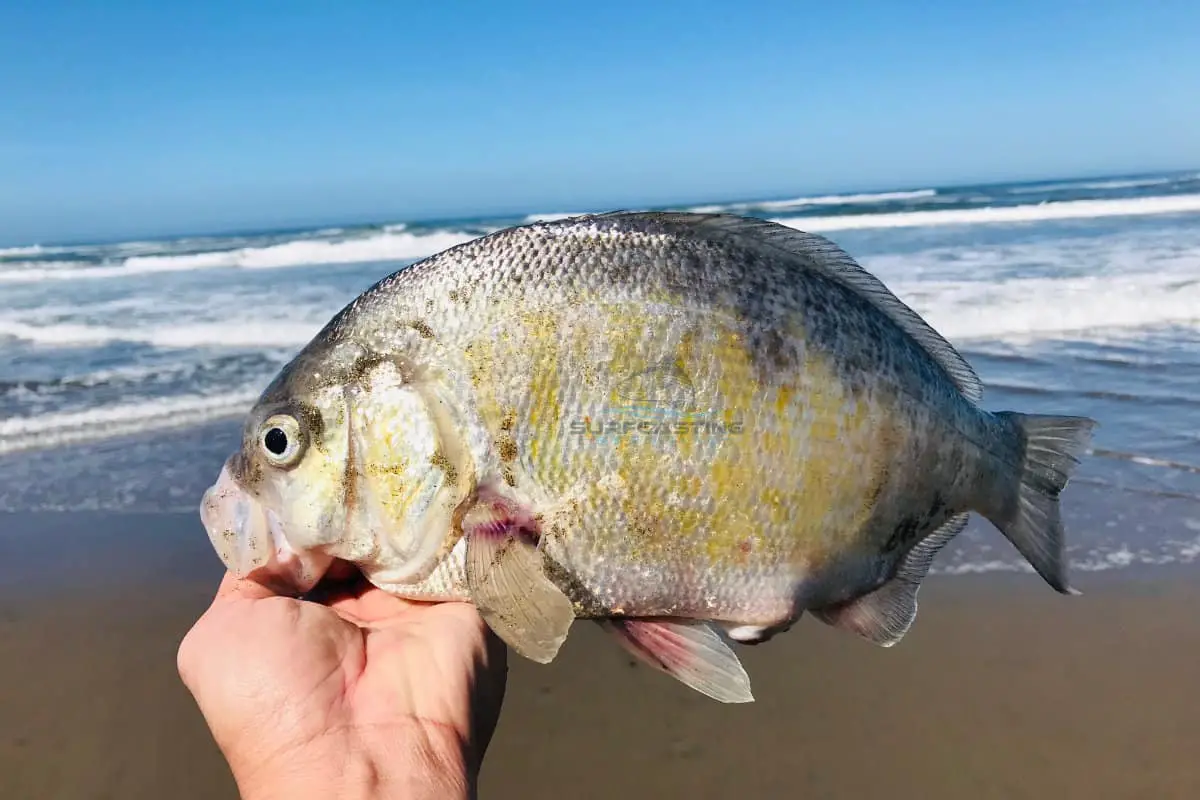Surfperch are one of the most popular fish that coastal anglers go after, and with good reason—these shining beauties are abundant, simple to locate, fun to catch, and delicious to eat. So, how do you surf fish for surfperch?
To successfully catch surf perch, you need the right tackle equipment— different kinds of bait and lures to present. You want to head for the shore about 2-3 hours before high tide. Fish with the outgoing tide until the biting stops. Study the water — The fish will use any trough, or dips in the sand just offshore, to cross between pockets.
Do you want to catch some surfperch but don’t exactly know where to start? Read on and find out more about these silvery panfish and how to snag some for yourself.
Understanding Surfperch
Before you can head to the ocean and wade in the surf, you must first take some time to understand your aquatic opponent.
What Is Surfperch?
Surfperch are one of the most numerous types of schooling fish found on coastlines around the world, and there are so many of them that they form their own family in the animal kingdom–the group of fish known as Embiotocidae.
What are the Different Type of Surfperch You Can Catch?
This family of fish species includes the following common gamefish:
- Silver surfperch (Hyperprosopon ellipticum): These silver-colored fish can be found in the eastern Pacific Ocean. Surfperch are most often found in sandy surf zones along the coastline but can also be found in rocky shallows. Anglers usually catch these fish along the coast in both central and northern California.
- Redtail surfperch (Amphistichus rhodoterus): Redtail surfperch can be found both in coastal waters and also in brackish estuaries (seasonally) at the mouths of sea-bound rivers. Redtail surfperch are one of the only North American varieties that do not inhabit southern California waters; they are restricted to northern ranges.
- Walleye surfperch (Hyperprosopon argenteum): These silver surfperch with faint, vertical bronze stripes are plentiful and can be found in vast numbers off the shores of the eastern Pacific Ocean. Because they are relatively easy to catch, they are a popular choice for public pier fishing as well as surf fishing.
- Shiner perch (Cymatogaster aggregata): Shiner perch is a deep-bodied, golden-green color, and they are the most common fish found in their habitat, which makes them a fantastic choice for anglers to go after in large numbers. These perch are most often found around humanmade structures such as piers and jetties and tend to be found in areas that contain eelgrass.
- Rubber lip seaperch (Rhacochilus toxotes): This variety of perch is known for its extremely thick lips and is one of the more commonly found species of surfperch found on the California coastline. Rubber lip perch can be found in kelp beds as well as in California’s many bays and harbors.
- Barred surfperch (Amphistichus argenteus): Their vivid greenish-brown stripes easily recognize barred surfperch. Sand crabs form the bulk of their diet. This species of fish is short-lived compared to many other species; they do not often live past a year old. A short lifespan means that most barred surfperch are small and well-suited to light tackle
 .
.
Because there are so many varieties of surfperch that are abundant in both northern and southern Pacific coastal waters, surfperch are very popular among surf fishers in North America.
Tackle Equipment You Must Have to Catch Surf Perch
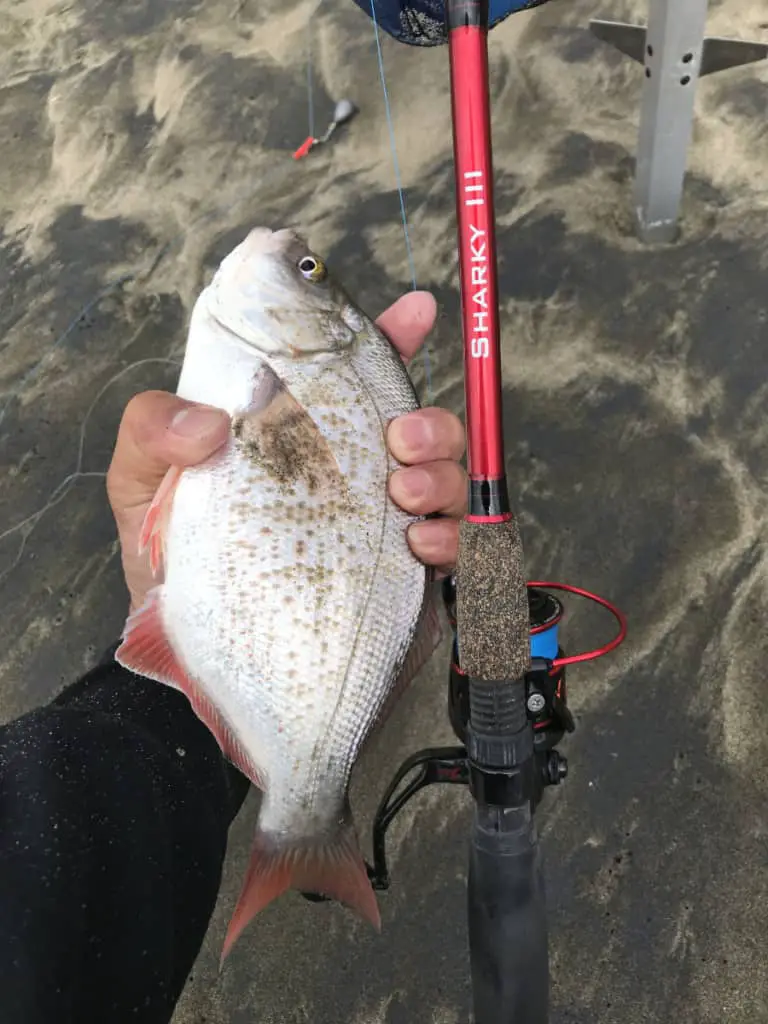
While there are many different kinds of jig and rig setups for catching surfperch, here is the set-up that I use to catch them.
Spinning Rod
On surf perching, an 8 to 10-foot medium-fast action surf rod ![]() is ideal for surf fishing these fish due to increased line sensitivity and better hook settings. Along with a high-quality rod, you also want to choose a reel that will last.
is ideal for surf fishing these fish due to increased line sensitivity and better hook settings. Along with a high-quality rod, you also want to choose a reel that will last.
Most reels have several moving parts, and your reel must withstand the harsh effects of the sand and saltwater. Thus, you want to look for top-quality when selecting a reel.
Saltwater Reel
I recommend a 3000 to 6000 sized saltwater spinning reel![]() . Saltwater reels
. Saltwater reels![]() are built out of anti-corrosive materials that can be exposed to salt spray and other surf zone environmental conditions without becoming degraded by oxidation or other problems related to salt damage.
are built out of anti-corrosive materials that can be exposed to salt spray and other surf zone environmental conditions without becoming degraded by oxidation or other problems related to salt damage.
What Line Is Best For Surf Perch Fishing?
Every angler has their preferred fishing line![]() , and you may want to use your go-to line when fishing for surf perch, but braided lines are the most popular line for surf fishing.
, and you may want to use your go-to line when fishing for surf perch, but braided lines are the most popular line for surf fishing.
I recommend using a 30-lbs braided line as a mainline![]() . You want to use a mainline that will not break in the surf but is still sensitive enough to detect when something bites.
. You want to use a mainline that will not break in the surf but is still sensitive enough to detect when something bites.
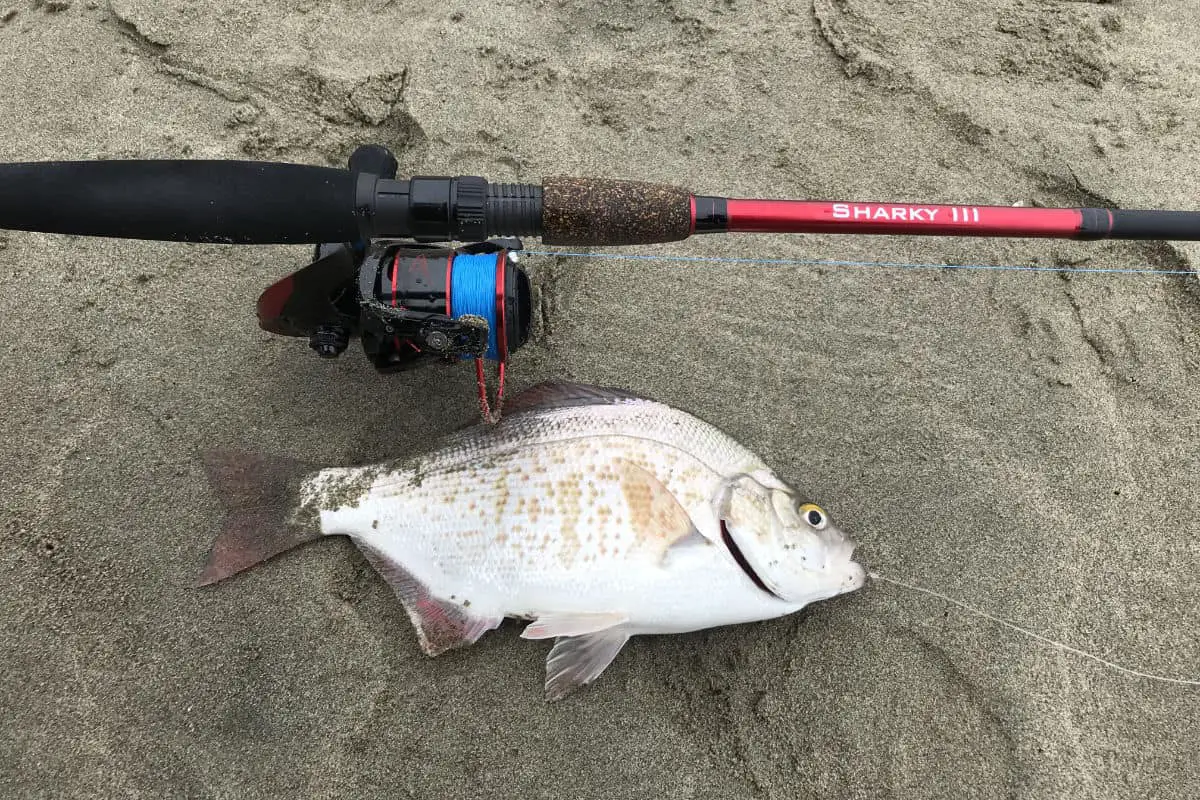
Some anglers will say, it’s too much for surf perch fishing, but for me, you don’t know what you are getting out there, sometimes if you are lucky, you can also hook stripers.
What Kind of Hook and Sizes?
Fortunately, hooks for live or dead-bait fishing just come down to two types: circle and “J.” Circle hooks have a circular shape as the point curves back towards the shank. A J hook has its point lying parallel with its shank forming a letter “J.”
Both types of hooks will let you catch a surfperch, but each type offers its own benefits.
For instance, the Circle Hook:
- Has a high “hook and hold” rate for easier catches
- Is environmentally friendly, catching the corner of the mouth
- Does not require set up
On the other hand, the J hook:
- Works well with fast-moving, live bait as well as larger baits
- Is more available than circle hooks in tackle shops
- Works well with many different fish species of varying sizes
- Good for artificial lures
My preferred hook, when catching surfperch, is #2 or #4 circle hook. Once in a while, I used a baitholder hook when I’m using sand crabs and sandworms.
For lures, depending on the size of the soft plastic lures, I use size 4.0 or size 6.0 baitholder hook.
But most of the time, I preferred using a circle hook. The reason why I like using a circle hook is due to not worrying about setting the hook when I got a bite.
What Materials do You Need For Surf Perch Rig Setup?
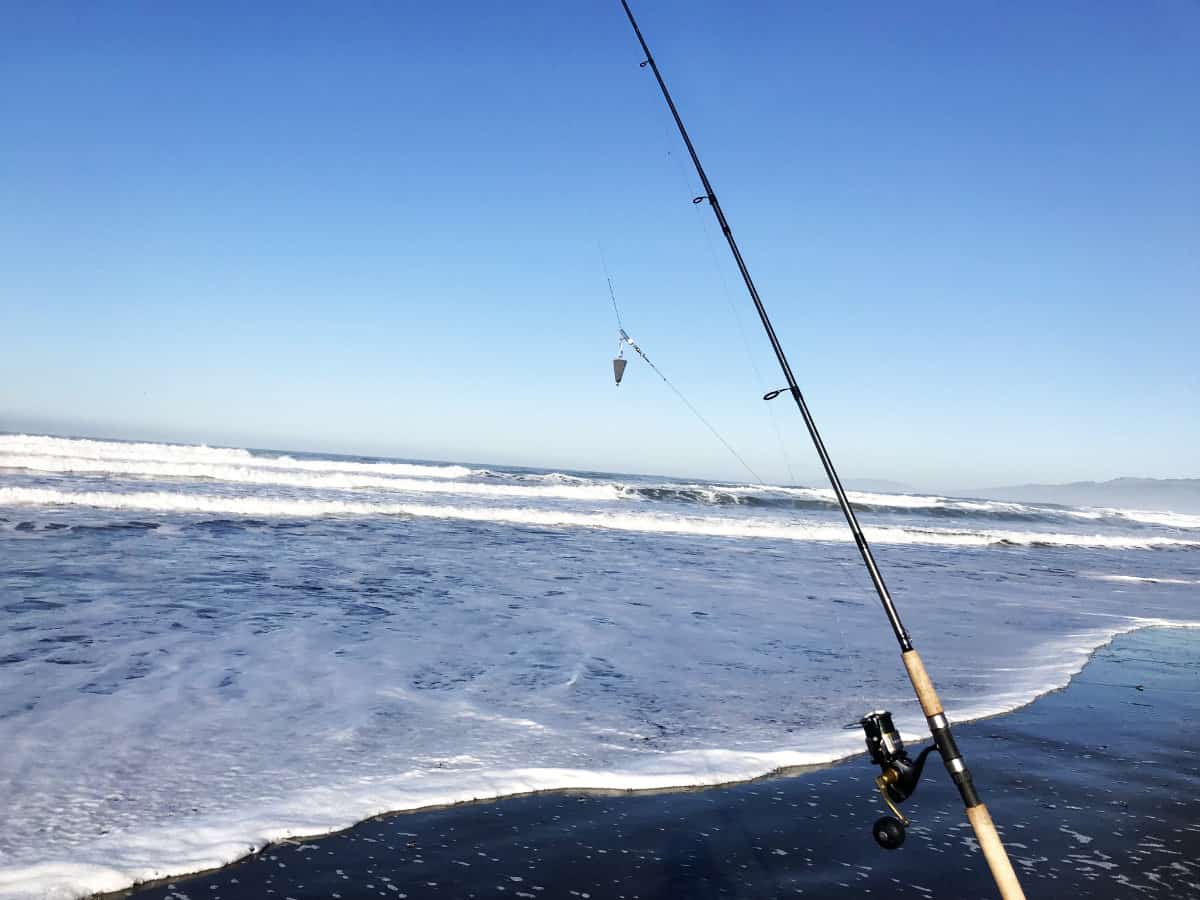
There are several tackle rigs used in surf fishing that are good for catching surfperch. But to be able to make these rigs, you’ll going to need these materials.
Fluorocarbon Leader
While not as popular as braided lines, fluorocarbon fishing lines are excellent for leader’s use. They are the most transparent line on the market, making them effectively invisible to the fish.
Fluorocarbon also features the strength and abrasion resistance of monofilament lines with the weight and stiffness of braided lines.
I recommend using a fluorocarbon leader![]() , at least 20-25 lb. with 3 to 5 feet long. Leader lines are often used in conjunction with swivels and sinkers for surf fishing.
, at least 20-25 lb. with 3 to 5 feet long. Leader lines are often used in conjunction with swivels and sinkers for surf fishing.
Sinkers
A sinker![]() is necessary when surf fishing for surfperch because the current tends to drag your lure or bait. My recommendation on the sinker, depending on the current or wave action, I use 1-oz to 3-oz weights. You can always adjust to meet your needs.
is necessary when surf fishing for surfperch because the current tends to drag your lure or bait. My recommendation on the sinker, depending on the current or wave action, I use 1-oz to 3-oz weights. You can always adjust to meet your needs.
There’s a lot to choose from but![]() , pyramid sinkers are popular for surf fishing because they resist being rolled along the ocean floor like round or bullet-shaped sinkers.
, pyramid sinkers are popular for surf fishing because they resist being rolled along the ocean floor like round or bullet-shaped sinkers.
Slider Sinker and Beads
Slider sinker is where you can attach your weight and change it quickly, and it slides on your mainline or your leader. Beads are used to protect the knot connection on your swivel. Sometimes edges on the sinker and slider sinker are sharp; this will protect your knot.
Swivel
A swivel is a piece of terminal tackle that acts as a joiner between the leader line and the mainline, allowing the leader line to swivel freely, so the mainline doesn’t become twisted.
Those are the materials you’ll be going to need to make a rig for surf perch. Below are my three favorite rigs to use for surf perch fishing:
Best 3 Rig Setup to Catch Surfperch
Fish Finder Rig
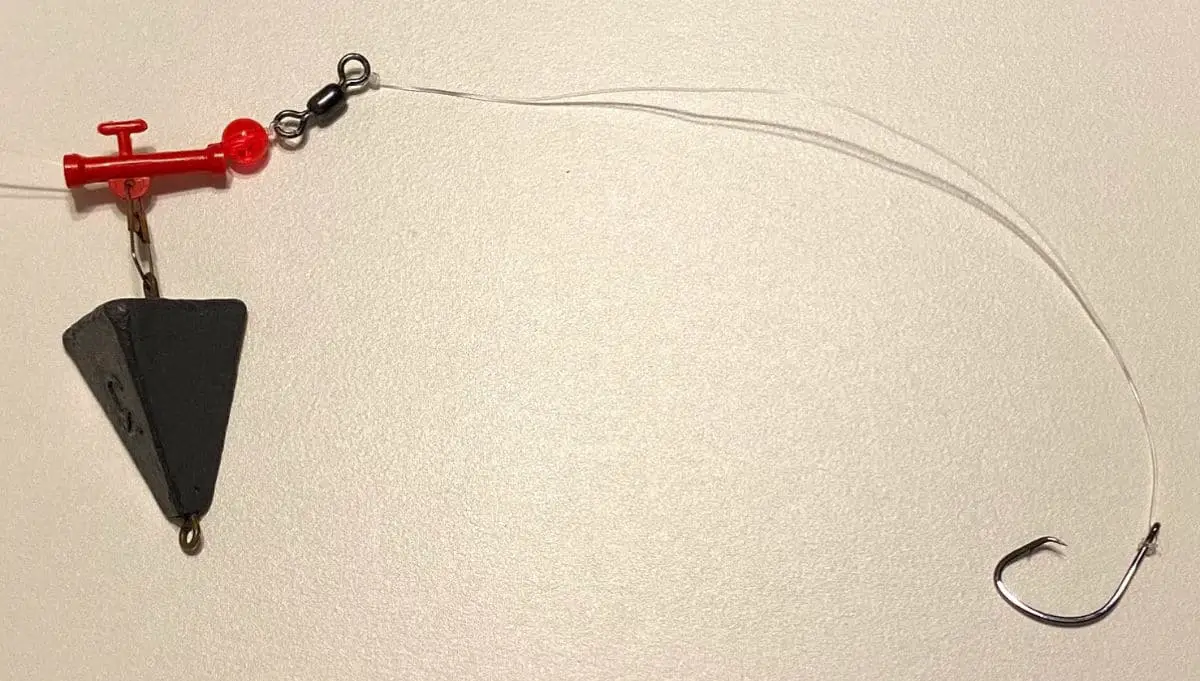
A fish finder rig is considered by many people to be one of the best surf fishing rigs. This rig uses live bait with a fluorocarbon leader and slider sinker attached to your mainline or leader.
List of materials that you’ll going to need for this set-up:
- Fluorocarbon leader 3 to 5 feet (20-25 lbs personal choice)
- Hooks #2 or #4 circle hook or baitholder hook.
- Pyramid Sinker (1 oz to 3 oz)
- Slider sinker
- Beads
- Swivel
Hi-Low Rig
A hi-low rig is a perfect setup for someone who wants to have two hooks going at the same time but doesn’t want to set up two separate rods.
Hi-low rigs allow the angler to place two hooks on their line instead of one, locating one hook higher on the line and an additional hook further down with a piece of heavy terminal tackle on the end to weigh everything down.
List of materials that you’ll going to need for this set-up:
- Circle hook #2 or #4. “J” hook I used 4.0 or 6.0
- Leader line. I used 30 lb. fluorocarbon
- Pyramid sinker. I used 1-3 oz, depending on the current.
Carolina Rig
Carolina rigs![]() are used primarily to help keep lures on or near the bottom of the water they’re in, which is a useful tactic for hunting surfperch since they tend to forage off the ocean floor.
are used primarily to help keep lures on or near the bottom of the water they’re in, which is a useful tactic for hunting surfperch since they tend to forage off the ocean floor.
Like the fish finder rig, a Carolina rig is a great choice when you are using plastic lures, swimbaits, gulf sandworms, etc.
List of materials that you’ll going to need for this set-up:
- Egg sinker 1-3oz, attach to your mainline
- Beads
- Fluorocarbon leader 6-10 inches.
- Swivel
- “J’ hook
Those are the best three rigs that I’ve been using for surf fishing. If you’re a beginner, I would recommend starting with the fish finder rig. It’s the simplest rig to set-up, and you can catch any type of fish with it.
Best Bait To Catch Surf Perch
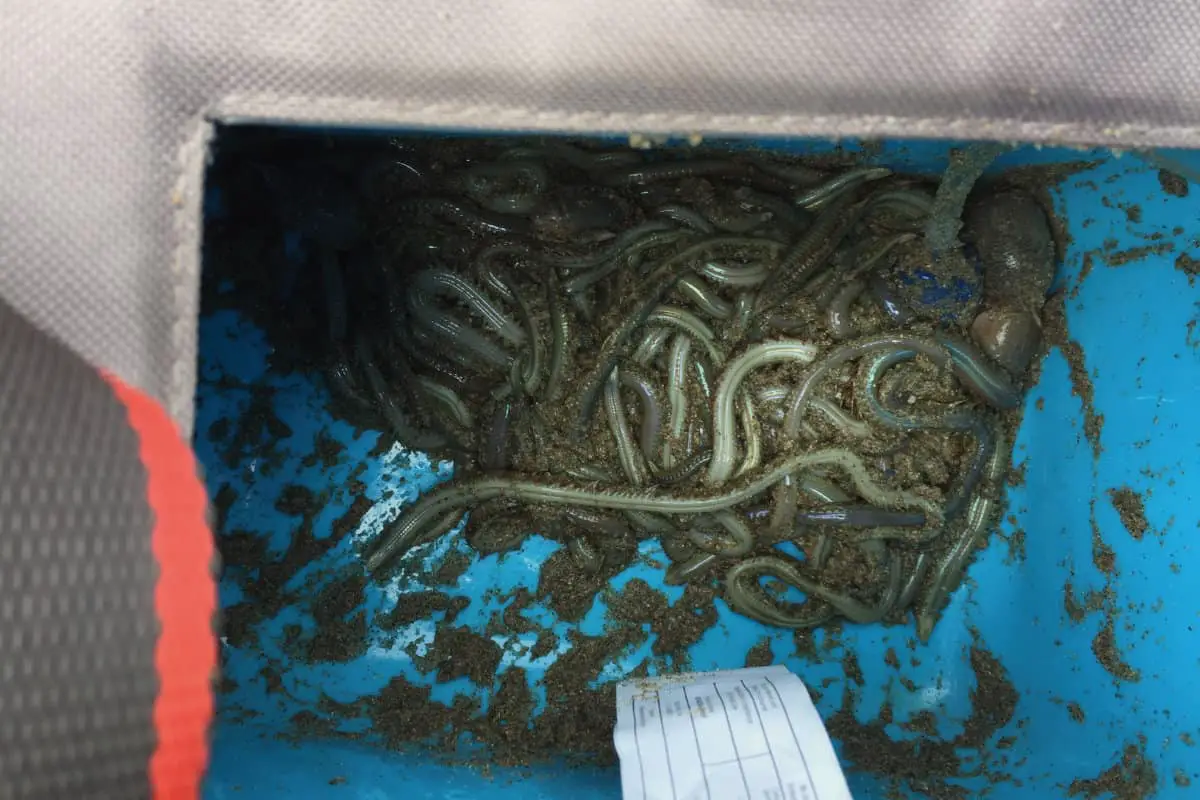
Both live bait and artificial lures can be used effectively in conjunction with other light tackle to catch surfperch![]() .
.
A form of surfperch fishing that is very popular other than using artificial lures (or sometimes in combination with using lures) is using fresh bait.
Here are some of the most popular forms of bait used when surf fishing for surfperch:
- Sand crabs: Sand crabs are of the surfperch’s favorite foods by far. One of the perks of this bait is that it can easily be found along most beaches where you’ll be surf fishing already. Catching sand crabs for bait while you wait for fish to bite is a fun way to pass the time.
- Sandworms: Sandworms are my other go-to live bait when surf fishing for perch. I’ve caught a lot of surfperch using this bait. They are easy to find, and you can dig them up on the shore using a fork shovel during low tide
 .
.
- Cut squid: Cut squid can be an attractive bait for surfperch and many other kinds of coastal fish but keep the cut pieces of bait small to avoid attracting larger fish such as sand sharks or rays unless you’re open to catching those too
- Bloodworm: Another type of worm that is very popular for every angler. Bloodworms are bigger and thicker than sandworms. You can purchase them in your local tackle shop.
- Cockles/mussels/pipis: These small shellfish can be found on the shores of almost any coastline and can be crushed to expose the meat within and then hooked for bait. These shelled animals are very popular prey for foraging fish in the surf.
- Ghost shrimp: Saltwater ghost shrimp can be a fantastic choice of bait for surfperch. However, due to their delicate nature, they can be easy for surfperch to strip and poach off of the fishing line if they aren’t rigged carefully.
The first two are my favorite bait for surf perch fishing. It’s free, and you can just catch them on the shore.
Best Artificial Lures And Swimbaits That Works For Surf Perch
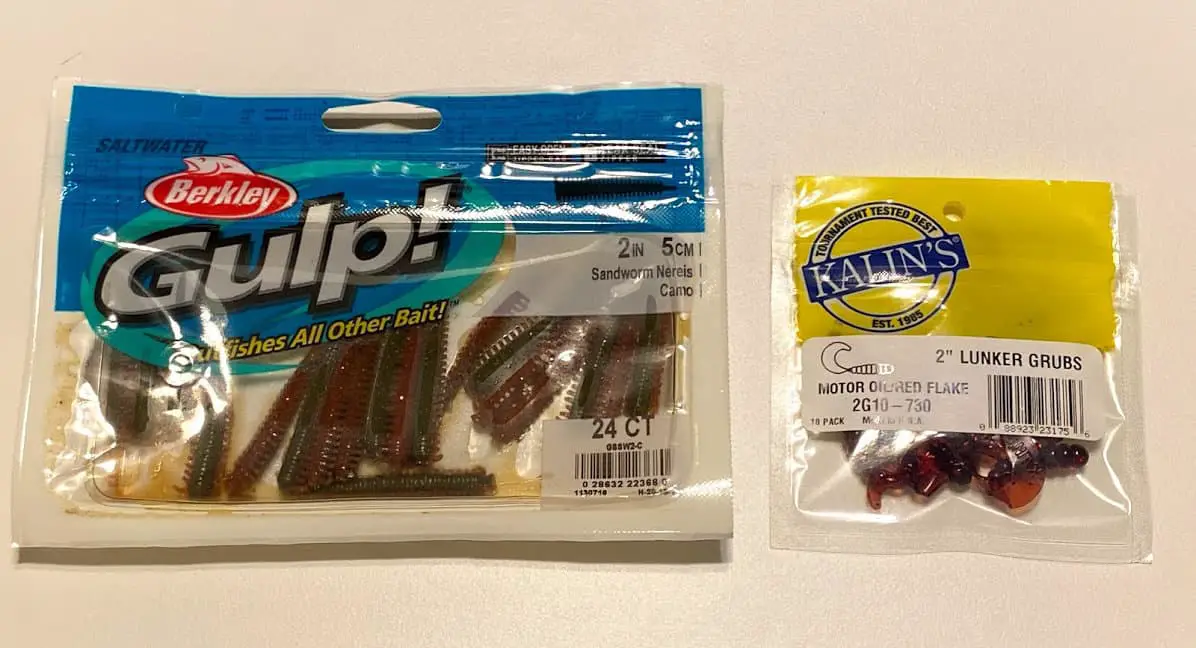
Swimbaits are soft plastic, an artificial lure that is designed to move through the water like a wounded or dying baitfish. In many cases, these lures are artificially scented to make them more appealing to game fish.
Here are my recommended plastic lures for surf perch fishing:
Swimbaits
“Grub Motor oil” is a popular color choice for curly-tailed swimbaits, and often include attention-grabbing additives like glitter or gold flake for added reflection in the water.
While simple in design, these curly-tailed, molded-plastic swimbaits come in a variety of different colors.
Berkley Gulp Sandworms
These artificial lures are designed to look and move like real live sandworms, which are favored prey of the surfperch.
Saltwater Lucky Craft Flash minnow
Lucky Craft lures are a topwater plug that skips along the top of the water like a panicked baitfish. These lures create a popping action that draws fish towards them, using both noise and sight-based triggers.
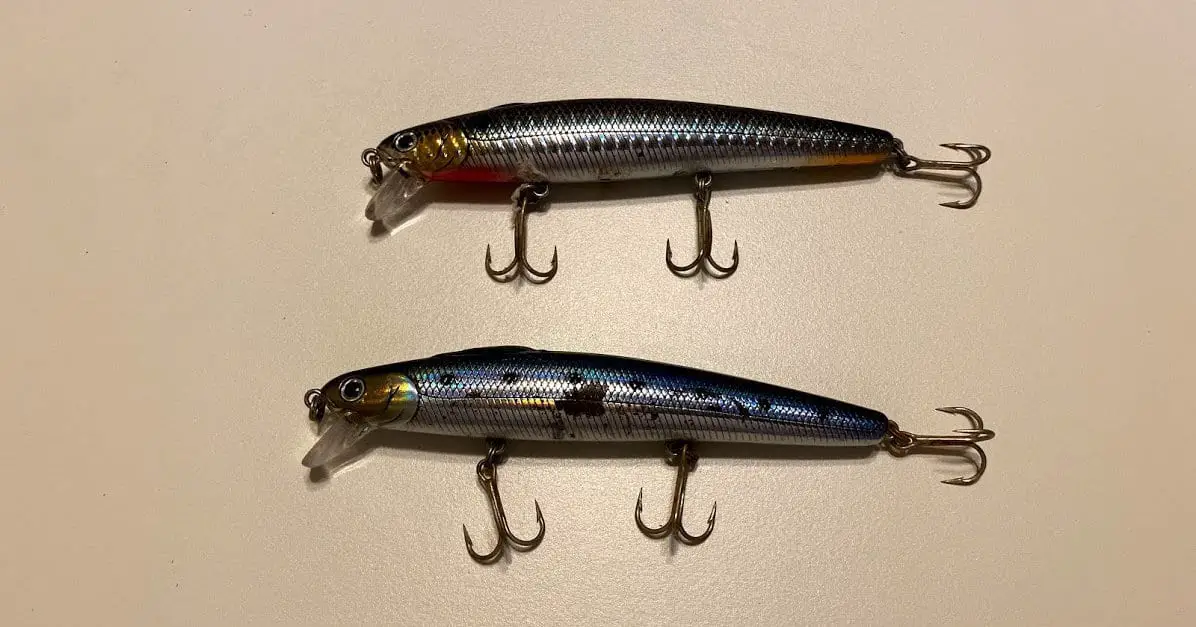
No matter which swimbait you go with, the main advantage of using one is that they are very attractive to fish that actively seek out wounded baitfish, this includes most of the game fish that are present in coastal surf zones.
This makes swimbaits very versatile lures for catching a wide variety of surf fishing targets, not just surfperch.
What Supplies to Bring Surf Fishing for Surfperch?
There are several things you’ll need to bring in addition to a rod and reel to go surf fishing for surfperch![]() . Here is a list of the supplies you’ll need for a successful surf fishing trip:
. Here is a list of the supplies you’ll need for a successful surf fishing trip:
- Extra Lures, hooks, weights, and other tackle
- Sand crabs net
- Live bait such as sand crabs or cockles
- Knife (for rigging lines, freeing/cleaning fish)
- Spare fishing line
- Pliers for unhooking fish
- Measuring tape (for posterity!)
- Rain gear
- Basic first aid kit
- Fishing license (required in most places for surf fishing)
- Water and snacks
- Sand Spike
Many of these items are both small and lightweight and can easily be packed into a backpack for convenient beach travel.
Bringing your fishing license is especially important since if you are approached by Fish and Game and do not have a fishing license, you can be fined or even lose your privilege to fish in the state you get caught poaching in.
While some of these items, such as a first aid kit, might seem like a little bit of overkill for a simple surf fishing trip.
You will regret leaving the first aid kit behind the minute you get finned by a surfperch or catch your finger with a hook and have to deal with saltwater being rubbed into the wound for a few hours.
You’ll also want to consider bringing along water, even if you’re going fishing in mild temperatures.
It is easy to become dehydrated while fishing and not realize it until you get sick or faint, so it’s better to carry plenty of water with you and prevent yourself from ever feeling ill.
Essential Surf Fishing Protection Gear
Angling perch, like any outdoor activity, is more fun and comfortable when wearing the right gear. Like any day at the beach, you need to be ready for the sun and water.

You should be suitably prepared and bring along the following equipment:
- Waders
 – You will spend tons of time standing in the water. While you could get away with board shorts and swim trunks, you may want something better and warmer if you plan to fish during the rough surf of high tide.
– You will spend tons of time standing in the water. While you could get away with board shorts and swim trunks, you may want something better and warmer if you plan to fish during the rough surf of high tide.
- Sunblock – the sun is not kind to skin, and you will be spending hours outdoors, exposed to the elements. Sunscreen will reduce your risks for skin cancer.
- Hat – You want a hat for the same reason you want sunblock –protection from the sun.
- Sunglasses – These can you keep your eyes safe from the water and the sun.
- UV buff – Buffs keep you cool while protecting your face from your nose to your neck.
- Ziplock bag – These are handy for storing fish and bait without a cooler or bucket. Most surfperch will fit nicely in a one-gallon bag. You can keep the fish colder by burying the bag in sand.
- Gunny sack – This is another excellent way to store your catches while keeping your hands free for other tasks.
- Cooler – a well-cooled cooler will keep your fish fresh for hours.
- Proper footwear – While you can surf fish in sandals, you might want hip boots to keep your feet and legs dry and warm in colder waters.
Surfperch Fishing Tips and Techniques
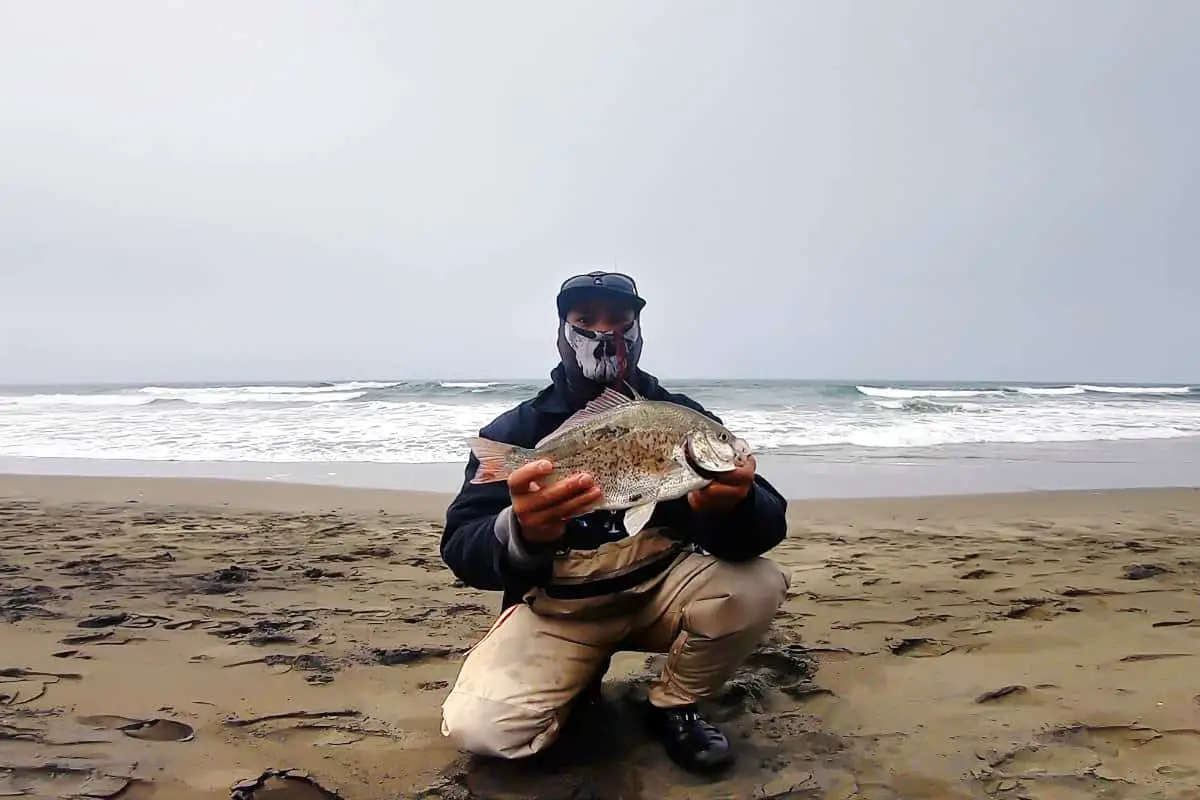
Surfperch fishing is all about studying the water and the fish to get the best advantage you can. No technique will work in all situations.
Surfperch fishing requires patience and dedication. The fish are out there. You just have to find them.
However, there are some routine things you can do while at your fishing location that can increase your chances of getting bites.
You may have to modify them to the current conditions, but these tips should work in most situations.
1. Start early – You want to head for the shore about 2 hours before high tide.
2. Stay late – Fish with the outgoing tide until the biting stops.
3. Study the water:
- During riptides, the fish eat the bait swept up by the raging sea.
- The fish tend to gather in calm “holes” or “pockets” in the water.
- The fish will use any trough, or dips in the sand just offshore, to cross between pockets.
4. Look for sand crab beds then try to cast your line on the sand bar edges.
5. Let the weight hit bottom to disguise your bait as something natural.
6. Pause and maintain line tension once your rig reaches the fish to put the bait in front of them.
7. Look for a steep sandy beach, trough, rip, cut, and holes.
Many anglers will move their rig between several pockets to cover more water, but you can just stick to one location if the fish keep biting.
Also, you may want to wait out any slow moments. Smaller perch may play with your lures before biting onto them.
If your first location does not have any signs of fish, you can cast your line past the first or second break in the waves, and then move along the beach.
The fish are always moving; so, you might have to move with them. You should never stay rooted in a single spot. Remember to reimplement the steps above as you shift your location.
Remember, you do not need to stand waist-deep in the surf. While standing in the ocean can get you more range, you might end up standing in a prime fish-gathering spot.
When Is The Best Time to Surf Fish for Surfperch?
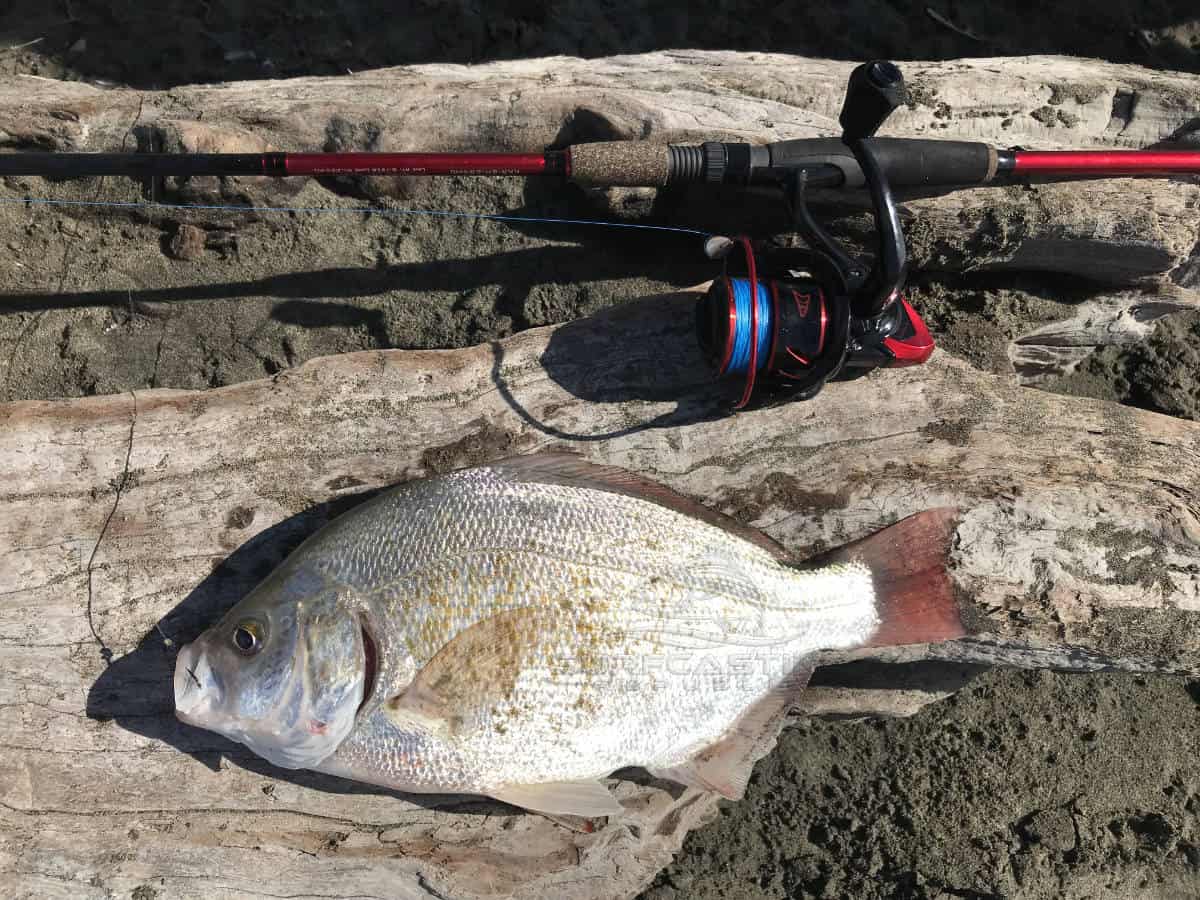
When fishing for surfperch, the best time is 2-3 hours before high tide and continue fish 2-3 hours the outgoing tide. Outgoing tide is where the surf perch were starting to bite.
Tidal patterns can have a substantial effect on how well the surfperch are striking and where they can be most easily found
The reason to fish between tides is that during the height of the high tide and the lowest depths of low tide, the activity of baitfish decreases, and the feeding activity of larger gamefish decreases too.
Surf fishing can still be accomplished at high and low tide, but the fish are not likely to be as active as they would be a few hours before this time.
When the tides are coming in or going out, baitfish are moved around by the shifting currents. This movement excites and attracts surfperch.
Tide tracking apps such as Tide Alert can help anglers know the exact time the tide is coming in or going out, and plan their fishing trips accordingly.
Knowing how to fish with the rhythm of the tide is vital to having success while surf fishing.
Where to Find Surfperch?
Surfperch like to hang out in sandy runs between the coast and sandbars (also known by anglers as “guts”) and rocky shallows, and these fish can be found almost anywhere on the Pacific coast.
However, there are a few specific areas where they are more likely to be found.
Surfperch favors gently sloping lines off the coast and can often be found feeding directly in the break of the waves.
Surfperch are also commonly found lurking near human-made structures, such as:
- Rock jetties
- Piers and docks
- Shipwrecks
To find a suitable surfperch fishing spot![]() , it is a good idea to scout the beach you want to fish during low tide before it begins to come in.
, it is a good idea to scout the beach you want to fish during low tide before it begins to come in.
Best Season to Catch Surfperch
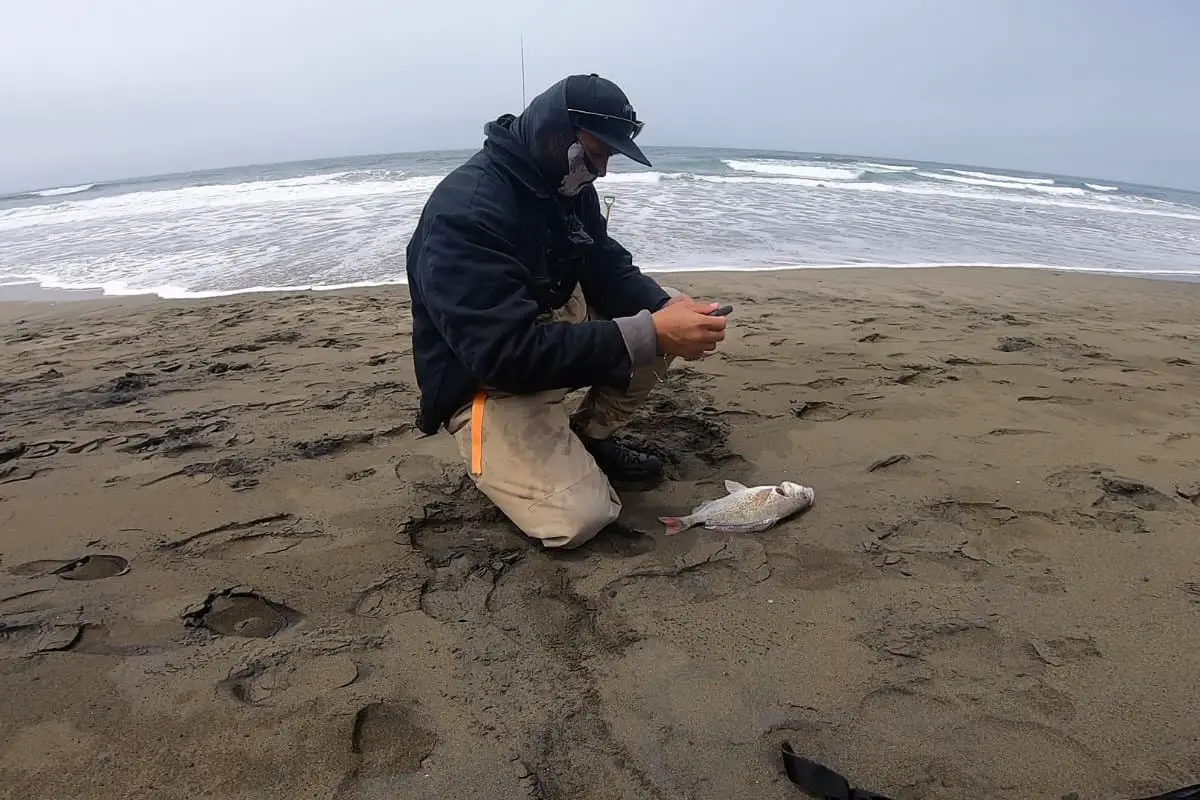
Surfperch can be caught year-round, which is one of the many reasons they’re such a popular coastal game fish.
However, you are more likely to find a lot of surfperch during the late spring and early summer.
This is because surfperch choose this time of year to shoal close to the shorelines for spawning. They are more actively feeding at this time and are easier to locate.
Weather Conditions for Surfperch Fishing?
When surfperch fishing depends mainly on the prevailing wind and water conditions of the day. There are certain weather conditions![]() where it is both easier and harder to catch surfperch.
where it is both easier and harder to catch surfperch.
Surf fishing in rainy weather is a matter of some debate, with some anglers claiming that storms cause coastal fish to bite less and recede to deeper waters.
In contrast, others claim to see heightened activity levels in surfperch both during and directly after a storm.
In any case, it’s worth taking shot in mildly rainy weather, but one important consideration to keep in mind is that when the weather is wet or stormy, the currents are rougher.
Not only does this deter some fish from traveling in the surf zone due to violently crashing waves, but it also increases the risk to the fisher.
Anglers are more likely to find themselves swept off their feet and dragged out by riptides in the currents driven by bad weather, so proceed with caution if you plan to go surf fishing in the rain![]() .
.
What is the Size Limit for Surfperch?
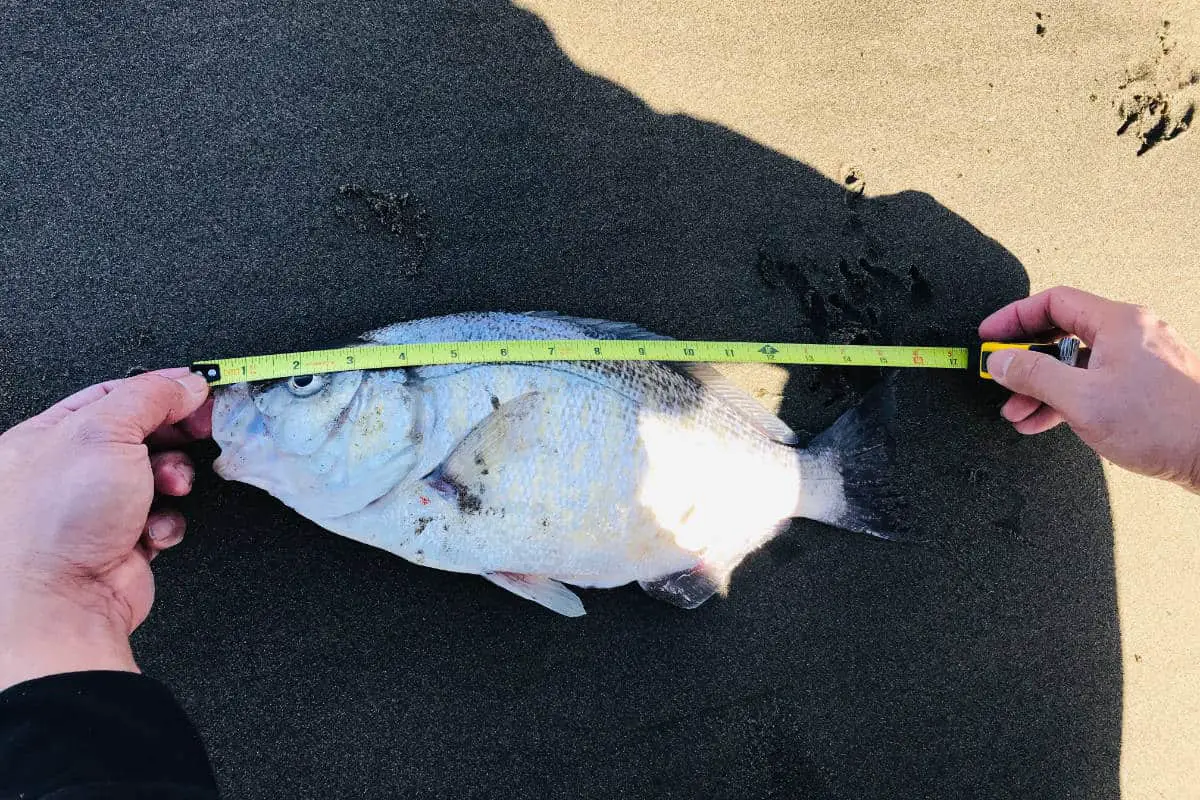
The only size limit that is enforced is on the Redtail surfperch, which has a minimum catch size of ten and a half inches (10-½ inches) there is no size limit on other varieties of surfperch.
How Many Surfperch You Can Catch When Surf Fishing?
The catch limit varies in every state, so make sure to check your state’s rules and regulations on![]() surf perch fishing.
surf perch fishing.
In California, except for shiner perch, you can keep 20 fish, in any combination of species, but no more than ten fish of any one species.
Final Thoughts and Other Considerations
Surfperch are fun and relaxing to catch, but only if you have the right equipment. While you do not need any specialized or dedicated equipment for surfperch, you do need the right equipment for the beach conditions and your level of experience.
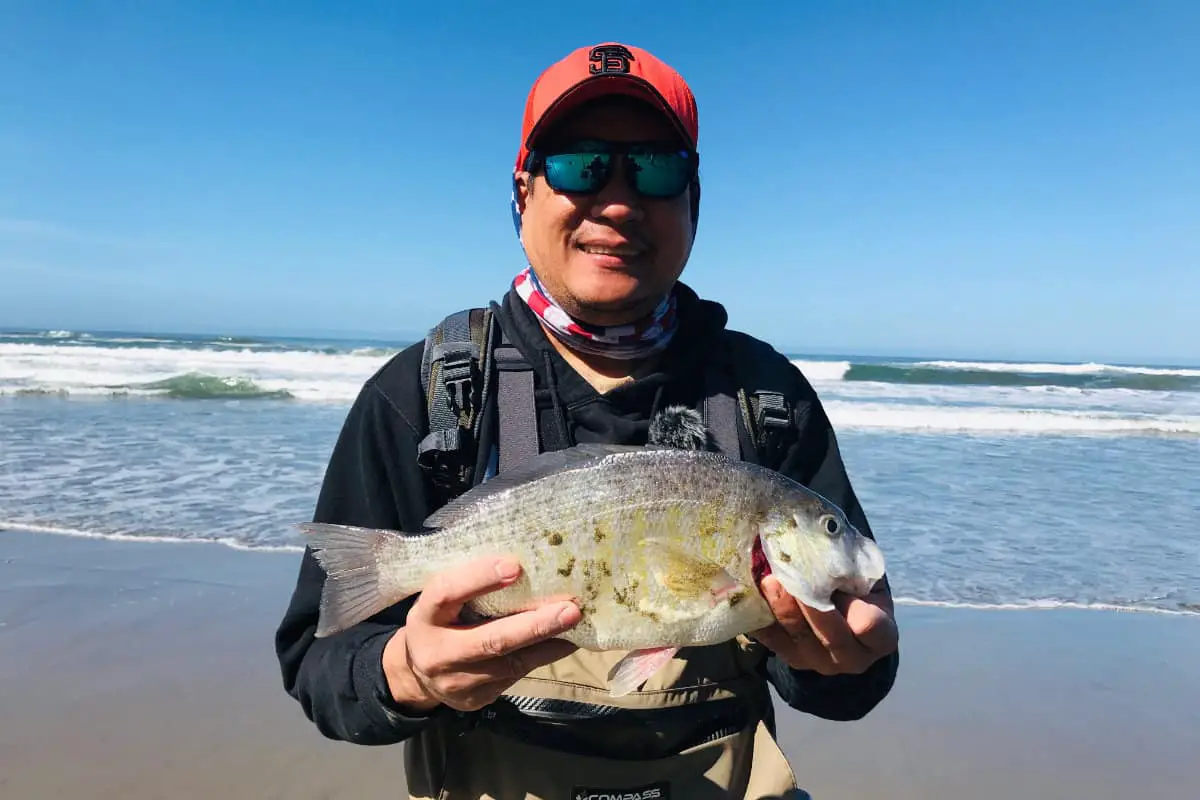
You also must know where the fish are. Though most surfperch gravitate toward the troughs near ocean beaches, you can find them in estuaries, bays, and near rocky ocean shorelines as well. You want water that is surrounding some sort of structure.
Be aware that many areas limit the number of fish you can catch.
In states such as California, you can catch 20 fish per day![]() . You should check with local regulations as the surfperch population can vary widely from year to year.
. You should check with local regulations as the surfperch population can vary widely from year to year.
Once you have everything set-up and ready to go, you can head over to your favorite beach by yourself or with friends for a great day of fishing perch in the surf!

